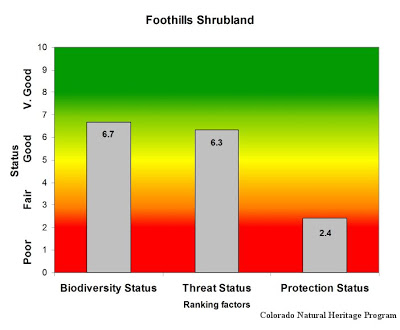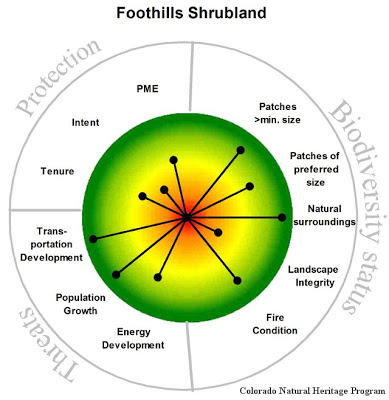
Foothill shrublands in Colorado are found in the Rocky Mountain foothills, ridges, canyons and lower mountain slopes, and on outcrops, mesas, and canyon slopes of the eastern plains. In general, these are mixed shrublands of areas where oak is absent, most common in the northern Colorado Front Range and drier foothills and prairie hills. Elevations are between 4,900-9,500 ft. Scattered trees may be present, but the vegetation is dominated by a variety of shrubs such as mountain mahogany, antelope bitterbrush, skunkbush sumac, or currant species. The dominant shrub species are generally well adapted to poor soils, dry sites, and disturbance by fire. Fire suppression may have allowed an invasion of trees into some of these shrublands, but in many cases sites are too dry for tree growth.
These shrublands are used by bird species including rufous-sided and green-tailed towhees, MacGillvray’s warbler, and broad-tailed hummingbird. A number of small mammal species are common in this habitat, including the rock squirrel, deer mouse, northern rock mouse, Mexican woodrat, and gray fox. There are few rare species exclusively associated with foothills shrublands, although they may be important for some insect and bird species. Rare species in adjacent habitats that may be found in these shrublands include the Columbian sharp-tailed grouse, Larimer aletes, and rare butterflies.
 |
| A rock squirrel (Spermophilus variegatus) doing its best to blend in. |
These shrublands cover less than 400,000 acres in Colorado. Our occurrences are generally in good condition, but underrepresented in protected areas. Most of these shrublands are on privately owned lands, although some large occurrences have been protected on city or county open spaces. Threats to this system include fragmentation by roads and development. These disturbances provide an unnatural fire break as well as a conduit for weed invasion.
 |
| Overall biodiversity, threat, and protection status scores for foothills shrubland in Colorado. |
 |
| A “windrose” graph depicting foothills shrubland status for individual scoring factors. |




